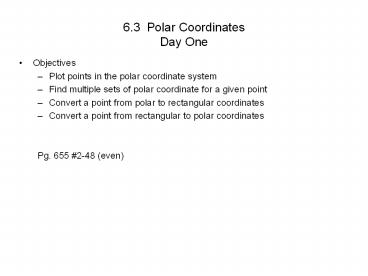6.3 Polar Coordinates Day One - PowerPoint PPT Presentation
1 / 9
Title:
6.3 Polar Coordinates Day One
Description:
6.3 Polar Coordinates Day One Objectives Plot points in the polar coordinate system Find multiple sets of polar coordinate for a given point Convert a point from ... – PowerPoint PPT presentation
Number of Views:141
Avg rating:3.0/5.0
Title: 6.3 Polar Coordinates Day One
1
6.3 Polar CoordinatesDay One
- Objectives
- Plot points in the polar coordinate system
- Find multiple sets of polar coordinate for a
given point - Convert a point from polar to rectangular
coordinates - Convert a point from rectangular to polar
coordinates - Pg. 655 2-48 (even)
2
Defining points in the polar system
- Location of a point is based on radius (distance
from the origin) and theta (the angle the radius
moves from standard position (positive x-axis in
a cartesian system) - (r, T) is the point in polar coordinates.
- r and T can be positive, negative, or zero.
3
The point described in polar coordinates by (2,
3p/4) would look like this
1. Plot the point (3, 315o) on the polar graph
provided.
4
2. Plot the point (2, 60)
3. Plot the point (4, 165)
5
4. Plot the point (-2, p)
5. Plot the point (-1, )
6
Multiple Representations of Points If n is an
integer, then the point (r, T) can be represented
as (r, T 2np) or (-r, T p 2np)
- Find another representation of (5, ) in
which - r is positive and 2p lt T lt 4p
- r is negative and 0 lt T lt 2p
- r is positive and - 2p lt T lt 0
7
Converting from Polar Coordinates to Rectangular
Coordinates
If cos ? x/r then x r cos ?
If sin ? y/r then y r sin ?
- Find the rectangular coordinates for the points
given in polar coordinates. - (3, p) 10. (-10, )
8
Converting from Rectangular Coordinates to Polar
Coordinates
From Pythagoras, we have r2 x2 y2 and,
thus, and basic trigonometry gives us
Step 1 Determine the quadrant in which the
point resides. Step 2 Find r by computing the
distance from the origin to (x,y) using Step 3
Find T using .
Make sure the angles fits the quadrant
determined in step 1. Note We are assuming
that r gt 0 and 0 lt T lt 2p
9
11. Find the polar coordinates of the point
whose rectangular coordinates are (1, - )
12. Find the polar coordinates of the point
whose rectangular coordinates are (0, -4)

